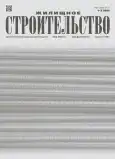Development of soviet Arctic cities based on polycentrism and preservation of identity
- Authors: Perov F.V.1, Lavrov L.P.1, Mangushev R.А.1, Pukharenko Y.V.1
-
Affiliations:
- Saint-Petersburg State University of Architecture and Civil Engineering
- Issue: No 1-2 (2025)
- Pages: 20-27
- Section: Articles
- URL: https://modernonco.orscience.ru/0044-4472/article/view/677180
- DOI: https://doi.org/10.31659/0044-4472-2025-1-2-20-27
- ID: 677180
Cite item
Abstract
The article deals with the development of Arctic cities, the planning structure and architectural appearance of which were formed during the Soviet period of development. Stabilization of the urban population is possible provided that monofunctional development is overcome, and a comfortable environment is created for the population to live in. The formation of a new system of cultural and consumer services, a modern architectural appearance of cities is possible with the formation of new public centers and a polycentric urban structure. The principles of the formation of public centers of Arctic cities are considered on the example of Kirovsk and the Kukisvumchorr microdistrict, which is part of its structure.
Full Text
About the authors
F. V. Perov
Saint-Petersburg State University of Architecture and Civil Engineering
Author for correspondence.
Email: f.perov@gmail.com
Candidate of Architecture, Docent
Russian Federation, 4, 2nd Krasnoarmeyskaya Street, Saint Petersburg 190005L. P. Lavrov
Saint-Petersburg State University of Architecture and Civil Engineering
Email: leonid.lavrov@gmail.com
Doctor of Architecture, Professor
Russian Federation, 4, 2nd Krasnoarmeyskaya Street, Saint Petersburg 190005R. А. Mangushev
Saint-Petersburg State University of Architecture and Civil Engineering
Email: mangushev.r.a@lan.spbgasu.ru
Doctor of Sciences (Engineering), Professor
Russian Federation, 4, 2nd Krasnoarmeyskaya Street, Saint Petersburg 190005Y. V. Pukharenko
Saint-Petersburg State University of Architecture and Civil Engineering
Email: pukharenko.j.v@lan.spbgasu.ru
Doctor of Sciences (Engineering), Professor
Russian Federation, 4, 2nd Krasnoarmeyskaya Street, Saint Petersburg 190005References
- Ivashkina I.V., Li M.Yu. Climate challenges: the best world practices of successful cities. Arkhitektura i stroitel’stvo Rossii. 2023. No. 2, pp. 60–64. (In Russian). EDN: BQNVCL. https://doi.org/10.55394/02357259_2023_2_60
- Detter G.H., Levkina A.O. Architectural cities of Russia on the way to smart sustainability. Arktika: ekologiya i ekonomika. 2023. Vol. 13. No. 2, pp. 180–187. (In Russian). EDN: XXHFTQ. https://doi.org/10.25283/2223-4594-2023-2-180-187
- Igolkin N.V. Development of the state-legal structure of Kirovsk until the end of the 1950s. Vestnik grazhdanskikh inzhenerov. 2019. No. 4 (75), pp. 5–12. (In Russian). EDN: YCMTYC. https://doi.org/10.23968/1999-5571-2019-16-4-5-12
- Halygina D.N. Statesmanlike transformations of Novosibirsk in the late XX – early XXI century. Vestnik grazhdanskikh inzhenerov. 2024. No. 4 (105), pp. 5–15. (In Russian). EDN: YCMTYC. https://doi.org/10.23968/1999-5571-2019-16-4-5-12
- Eremeeva A.F. Environment-forming elements of a tourist cluster in the Arctic region. Izvestiya vysshikh uchebnykh zavedenii. Stroitel’stvo. 2023. No. 6 (774), pp. 76–87. (In Russian). EDN: MFYWCQ. https://doi.org/10.32683/0536-1052-2023-774-6-76-87
- Eremeeva A.F. Architectural and spatial formation of tourist centers in the Arctic zone of the Russian Federation. Creative industries of the Arctic region: experience and development prospects. Materials of the All-Russian Forum with international participation. Murmansk. 2023, pp. 63–67. (In Russian). EDN: DBJPAG.
- Perov F.V. Architecture of crypto-climatic complexes for Arctic cities. Sistemnye tekhnologii. 2022. No. 3 (44), pp. 153–160. (In Russian). EDN: ZDMKIZ. https://doi.org/10.55287/22275398_2022_3_153
- Blagodeteleva O.M. Cryptoclimatic building. Arkhitektura i stroitel’stvo Rossii. 2016. No. 4 (220), pp. 111–112. (In Russian). EDN: XGYNHL
- Perov F.V., Mangushev R.A., Datsyuk T.A., Bolotin S.A. Typology of residential buildings for Arctic cities. Actual experience of design and scientific research of the Soviet stage of development of the region. Arkhitektura i stroitel’stvo Rossii. 2024. No. 3 (251), pp. 58–62. (In Russian). EDN: ABUUYH.
- Svechkar E.S. Theoretical methods as a justification for the typology of state institutions. Vestnik grazhdanskikh inzhenerov. 2024. No. 2 (103), pp. 15–26. (In Russian). EDN: VZJFKP. https://doi.org/10.23968/1999-5571-2024-21-2-15-26
- Poddaeva O. Modeling snow loads on the roofs of unique buildings. Architecture and Engineering. 2023. Vol. 8. No. 3, pp. 53–59. EDN: EOPHBU
- Fedosov S., Pulyaev I., Alexandrova O., Cherednichenko N., Derbasova E., Lezhnina Y. Thermophysical processes in hardening concrete as a factor in ensuring the quality of reinforced concrete structures of transport structures under construction. Architecture and Engineering. 2024. Vol. 9. No. 4, pp. 75–86. EDN: HYVFTH. https://doi.org/10.23968/2500-0055-2024-9-4-75-86
Supplementary files















